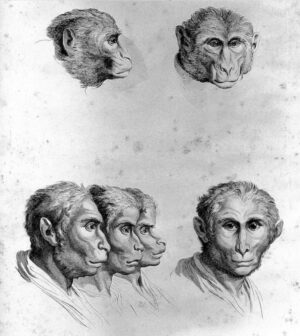
Other than the above traits and personality type configurations, what does it really mean to be you?
Here’s a simple equation which we believe has profound implications for how we understand our “selves”, also our life situation, past/present/future, and most importantly for our therapy journey together, how we deal with upset and suffering in our lives.
WE = INSTINCTS/LIFE FORCE/ENERGY + NATURE/TEMPERAMENT/PERSONALITY + NURTURE/CULTURE/LIFE-CIRCUMSTANCES
Let us break that down a bit for us.
INSTINCTS/LIFE FORCE/ENERGY
We often forget that we are animals. Human animals, but animals nonetheless.
What kind of animals are we? We are mammals, we are primates. And like all animals, we are “ruled” to some extent by our instincts.
Instincts are very simply our natural, automatic behaviours and reactions that have evolved over time to help us survive and thrive. These instincts are innate and serve to guide us through various aspects of our life.
As you read about the three most important human-animal instincts below that make up (y)our “life force”, ask yourself the following all-important question as a human-animal: which of these instincts “dominates” my life as a living creature, by and large?
Even though we utilise all three instincts, generally speaking, our basic functioning relies more heavily on one instinct (our dominant instinct), followed by a secondary “assistant” instinct, while a third instinct is usually “repressed” or under-utilised in some way.
This is because our life-force isn’t limitless (both whilst alive, and clearly when dead), and so our nervous systems and innate, instinctual functioning is often forced to make automatic instinctive choices for us in terms of where we focus our energies.
When you read through the following needs and focus of each of your three instincts, have a think about where your life-force mainly gets channeled (this would be your dominant instinct), as well as which instinct isn’t being given enough energy or attention:
THE SELF-PRESERVATION INSTINCT’S NEEDS AND FOCUS:
Self-care and wellbeing:
(1) Diet, (2) exercise, (3) sleep/rest, (4) relaxation (time in solitude, walk in nature, meditation, yoga, etc.), (5) adequate stimulation (reading, listening to music, healthy sex life, watching documentaries, etc.)
Maintenance and resources:
(1) Money/finances, (2) time-management (self-management, time to self, time with others, being on time, etc.), (3) practical application and skills (being able to address practical needs, fix things, manage life, etc.), (4) work habits/persistence (the ability to follow through, finish tasks, discipline, habits around practical ventures, ways you are handy, etc.), (5) energy management ((how we use our energy, deal with stress, balance silence with activity, etc.)
Domesticity and home:
(1) Comfort/domesticity, (2) safety/security, (3) structure supports life/base of operations (home management, home as a solid launchpad), (4) beauty and holding (comfortable and inviting living/workspace, feeling held by your home, etc.), (5) recharging/restoration (home as a place to restore).
[Further exploration: Is Your Self-Preservation Instinct Balanced, Over-Dominant, or Impaired? How does the Self-Preservation Instinct function in your life and show up in your personality style?]
THE ONE-ON-ONE/SEXUL INSTINCT’S NEEDS AND FOCUS:
Broadcasting and charisma:
(1) Transmitting (initiating energy that broadcasts), (2) display (doing behaviours to get yourself noticed, (3) being attracted and following energy, (4) choosing/fitness (evaluating attraction; auditioning and being aware of being auditioned), and (5), competition/winning.
Exploration and edge:
(1) Activation and arousal, (2) taking risks and having adventures, (3) getting out of comfort zone (breaking habits and feeling soggy in routine), (4) seeking stimulation, and (5) following and honouring impulses and inspirations.
Merging:
(1) Disappearing into something or someone (which is restorative as it gets us away from the egoic self), (2) intense focus and concentration applied to an activity, (3) losing boundaries and sense of self, (4) spending energy (pouring self into something and giving self wholeheartedly), and (5) seeking fusion and at oneness.
[Further exploration: Is Your Sexual/One-on-One Instinct Balanced, Over-Dominant, or Impaired? How the Sexual/1-on-1 instinct function in your life and show up in your personality style?]
THE SOCIAL INSTINCT’S NEEDS AND FOCUS:
Reading people and situations:
(1) Reading facial expressions/body language/tone of voice/moods, (2) reading between the lines, (3) interest in others/attunement/tuning in, (4) empathy/concern, and (5) adapting to cures/adjusting behaviour.
Connecting:
(1) Creating relationships: engaging others, (2) sustaining relationships: maintaining connections and knowing when to end them, (3) communication—speaking and listening, (4) cooperation/reciprocity and (5) play/shared enjoyment/celebration.
Participation:
(1) Getting involved or not: what do I participate in?, (2) need to contribute: something beyond my own needs, (3) enrolling: getting others interested and involved in what I am passionate about, (4) part of something bigger/sense of place, (5), belonging and welcoming.
[Further exploration: Is Your Social Instinct Balanced, Over-Dominant, or Impaired? How the Social Instinct function in your life and show up in your personality style?]
Instincts generally work and shows up for us subconsciously. This means that we might be thinking or feeling or behaving in certain ways that are largely governed by our instincts, even though we are unaware of them at work within us.
As we seem to be dominated by ONE of the three instincts, as well as under-utilising aspects of the other two, it can be helpful to consider ways in which we balance our instinctual drives throughout the day, as well as in our lives in general.
TEMPERAMENT/NATURE/PERSONALITY

“You” were once a baby. Babies don’t have fully-formed and expressive ego-functioning styles (aka personalities) which usually only come online in mid-childhood. But even as infants, we all have a very definite temperament or “nature”.
Regardless of our environment when growing up, some babies are more social, or playful, others less so. Some babies are generally quite compliant or easy-going, others are more difficult or demanding. Again, like our instincts, this stuff is just hard-wired into us as human-animals.
As with our instincts, we often forget or downplay our “natural temperament” when it comes to assessing or thinking about our lives, which can cause a great deal of emotional pain and suffering as our expectations on ourselves (as well as others) might be completely out of whack with who we really are and how we function, for better and for worse.
Our adult personality style is really just the “flowering” or “above ground” aspect of our temperamental/instinctual roots. This style will be affected by our upbringing to some extent (see the next section: NURTURE), just as a plant will grow in a more robust way in certain environments rather than others. But it’s probably wise to understand first and foremost whether we are a rose bush, or an orchid, or a sunflower.
NURTURE

The interplay between nature (genetics) and nurture (environmental factors) is complex and multifaceted, making it difficult to determine the precise extent to which our life-force/instincts + temperament/nature/ego functioning are influenced by upbringing and trauma. However, it is widely accepted that both nature and nurture play significant roles in shaping our personality, temperament, and ego.
Some key aspects of the nurture side of things which would be good to explore together when understanding “you” and how you show up in the world include: parenting styles, cultural influences, socio-economic status, and traumatic experiences. These factors can contribute to the formation of an individual’s temperament and ego functioning, but they don’t necessarily alter our basic instinctual and temperamental settings.
It is important to note that the influence of environmental factors can vary from person to person, depending on individual genetic predispositions and resilience. Some people may be more susceptible to the effects of upbringing and trauma, while others may be more resilient.
Understanding the complex interplay between nature and nurture is essential understanding how you function and this is something we will always need to bear in mind when thinking about “you”.
 SELF-PRESERVATION TWOS
SELF-PRESERVATION TWOS
Self-Preservation Twos are looking to experience the Essential Quality of love through attending to the well-being, comfort, and health of others. Self-Preservation Twos are warm, caring, and protective, but they have a practical side and a willingness to “roll up their sleeves” in order to get to work for the benefit of others. The energy of Type Two paired with the Self-Preservation Drive lends itself to putting others first and diligently striving for the benefit of everyone. They are classic providers and have a strong sense of obligation and responsibility that can appear Six-like.
Because of the Self-Preservation emphasis on the body and practical results, these Twos are warm but don’t often have the gregariousness of other Twos. Especially if they have a low Social Drive, the way they show their love and support may not often be as “personal” or as “face to face” as Twos dominant in Social or Sexual.
Their style of support tends to be practical, like financial support, some sort of skill in healing, or caretaking. It’s especially common for male Self-Preservation Twos to take on the role of material provider for family, clients, or employees. Their dedication and drive can make for an incredible capacity for selflessness and giving care, especially in times of crisis or when people can feel there’s no one else to turn to. Yet this often means Self-Preservation Twos neglect their own self-care and run themselves ragged for other people with the unconscious expectation that others will be there in their own time of need.
Self-Preservation Twos feel compelled to put energy toward others’ benefit, but they also need plenty of downtime. When psychologically healthy, they rest, but may find difficulty in actually relaxing under the judgment of their own superego. Time and energy not focusing on the benefit of others can create anxiety. They may withdraw or self-indulge in food or idle time to compensate for the care they feel they’re not getting. This gives the appearance of self-care without the actual care.
In some cases, Self-Preservation Twos have been so caught up in performing a function for others or in occupying a caretaking role that they may not know how to relate to others without having something to offer. Despite all their helping, they may not have formed a bond on the personal levels they thought or wanted because it had all been contingent around a dynamic of offering support. This situation compounds the feeling of being uncared for, which their superego takes as a sign they’re not doing enough. The Pride of Self-Preservation Two often means they take on a persona of having things together, of having a kind of expertise or skill that reflects on them as being the indispensable go-to person for certain needs. In extreme cases, this can lead to the Self-Preservation Two essentially performing roles and tasks they’re not qualified for simply for the sake of being needed by others. A major danger faced by this type is squandering their natural gifts and talents in their efforts to give others attention and support.
A pattern can emerge in which Self-Preservation Twos can be overly-willing to sacrifice their personal comfort and well-being in the service of others. They can use their own exhaustion as a kind of proof to themselves that they’re not acting out of self-interest. Self-Preservation Twos are especially prone to somatizing emotions and may unconsciously use physical illness as a way of eliciting care and attention that they feel they can’t ask for directly.
Self-care and caring for others come to be mutually exclusive in the mind of the Self-Preservation Two. Over time, a lack of adequate self-care paired with a Two’s difficulty in directly asking for what they need can create a pattern of resentment and entitlement. They jump into situations to provide support to others in the hopes of being cared for in return, but those who benefit from the support can become habituated to it without understanding the Two’s expectations for reciprocation or the amount of energy the Two is spending. Twos can then feel that their boundaries have been impinged on, occasionally culminating in eruptions of devastating anger.
Acknowledging and accepting their own needs with the same quality of mercy they so generously direct to other people can help Self-Preservation Twos cultivate their own well-being and personal gifts. To be truly loving, Twos need to learn to regard their own vulnerable organism with love and acceptance. This presence with themselves begins to expand their own sense of what love is and means, allowing them to be more abundantly available to themselves and others.
[This article explores in greater depth how the Self-Preservation Instinct functions in our lives and emerges through our personality style]
SEXUAL TWOS
Sexual Twos long to find the Essential Quality of Love through their romantic relationships and attractions. Sexual Twos often have a coquettish persona, and they typically know how to turn up the intrigue and sexual tension while still retaining a “good” image. They tend to have vivacious personalities and a provocative sense of humor, with a sharp intuition about what others will find desirable.
Many have talents that lend themselves to performing arts like music or theater, where they can display themselves in a big way. They tend to offer guidance to others in romance, sexuality, and beauty, so it is common to find Sexual Twos working as relationship coaches, sex therpaists, perfomers, or helping people improve their desirability.
Sexual Twos understand that it’s attractive when someone is attracted to you, so they are typically very forward and flirty toward the object of their desire. They often lavish them with attention, as if to suggest that they’re so alluring that the Two just can’t help their powerful infatuation. There’s often a sense Sexual Twos convey to potential partners that being together is simply inevitable. More than any other type, Sexual Twos tend to instigate and feed off explicitly sexual energy yet are charming enough to diffuse tension before it becomes too uncomfortable.
Sexual Twos often struggle with craving nearly constant attention from the object of their desire and have learned how to be attention-grabbing in order to keep it. This betrays an often deep-seated insecurity around their own genuine attractiveness and about their ability to maintain that attraction over a period of time. They might be physically beautiful but have severe insecurities that their personality is repellant, or they might simply worry that they themselves can’t keep attraction and passion intense enough, whether or not this is a real concern of their partner.
When attracted to someone, Sexual Twos may try to force a relationship in a variety of ways. They often initiate a great deal of physical contact and may study the habits of their desired partner, “coincidentally” showing up at favorite hangout spots, finding excuses to call or show up to their home, etc. They may even arrange “accidents,” like locking themselves out of their apartment in a snowstorm, which forces them and their object of infatuation together.
Even relatively balanced Sexual Twos have a difficult time not being in a relationship, so infatuation based on very little is a frequent occurrence. They may even talk themselves into being attracted to certain people in order to force the chemistry. They are prone to lacking in trust that they’ll be attractive by simply being themselves, and so to overcompensate, they can go to great lengths to become literally all things for their partner—lover, friend, coach, parent, and business partner. The Sexual Drive combined with the Pride of Two often manifests as over-doing efforts to attract, allure, and occupy their partner’s attention while often not being real with themselves about the true state of their own attraction. They may have so much emotional reactivity around losing their partner’s interest that they may be unaware if they themselves have lost attraction to their partner instead.
Sexual Twos who are imbalanced may throw themselves at any potential partner who reciprocates, or, conversely, at those whose attraction is most difficult to earn. This can lend itself to the Sexual Two choosing partners who aren’t up to their intellectual and emotional level, who take them for granted, or who reinforce a negative psychological status quo. Preoccupation with people who are simply not interested in them is also a common pattern for Sexual Twos, in that their ego may take the challenge of earning a disinterested person’s attraction as proof of their desirability. Serial monogamy and sex addiction are common for struggling Sexual Twos.
When insecurity around desirability sets in, the Sexual Two can become invasive, both in terms of trying to receive sex and attention as reassurance, as well as acting out intense possessiveness, jealousy, and control. The self-rejection of the unhealthy Two personality can lead to undergoing various kinds of cosmetic modification to be more physically appealing. This can become exaggerated and caricaturish in deeply unhealthy levels, as the Two will further reject their natural appearance and try to eliminate any vestiges of their true look. Alternatively, if their insecurity is about facets of their personality, they may try to adapt the preferences and tastes of their partner.
When unbalanced, Sexual Twos can engage in exaggerated displays of love, attraction, devotion, and simply assume that they are the best possible partner for their object of desire. Obsession with someone as a “soulmate” may consume them, but they may lack discrimination, believing that nearly anyone could “the one”.
When they’ve set their sights on someone, they can excuse their own intrusive behaviour by rationalising that their object of desire will come around eventually. They may begin to feel entitled to their partner’s attention and act out intense possessiveness, extending into control over the entirety of the partner’s social and family life.
They can feel consumed by jealousy at the slightest indication that their partner is asserting an independent will.
Sexual Twos can learn to relax into love by recognising that their intense craving for others is mixed with neediness stemming from ways that they’ve self-abandoned. Investing some of that outward energy back into their own presence, their fears around undesirability and being overlooked can be quelled. This self-investment and self-attraction can become a source of authentic self-love and self-acceptance.
[This article explores in greater depth how the One-0n-One Sexual Instinct functions in our lives and emerges through our personality style]
SOCIAL TWOS
Social Twos seek to experience Essential Love in their relationships, vocation, and their sense of belonging. Social Twos are typically deeply involved with people and have a great deal of energy for relationships. People of this type combination are typically skilful in creating and fostering close connections with charm, humour, and eccentricity. Because of this, they have wide social networks, typically serving as a central axis within their milieu. Social Twos tend to have influential and persuasive personalities, and yet are adaptable enough to be able to attune to a variety of different kinds of people to meet them on their level.
Many Social Twos are teachers, mentors, and guides who are willing to give time and energy to people that others have deemed broken, unlovable, or unreachable. Most Social Twos don’t want to be the leader or figurehead of organizations or groups because it often prevents them from having one-on-one time with others, and such a position may act as a boundary that gets in the way of intimate relating. While they may not want to be the leader, they often gravitate toward positions of influence that allow them to be ongoingly involved with others and ensure their sense of belonging and social value.
Social Twos have deep fears of exclusion, both in interpersonal relationships and in their social context. Therefore, they may acquire specialised relational skills in order to have something to offer to those who make the effort to connect with them. They are also likely to insert themselves into other people’s relationships and affairs as necessary connective tissue and into conflicts as mediators.
Pride can make it hard for Social Twos to see the extent of their social positioning and interpersonal meddling. Because of the Social Two’s emphasis on positive intentions and loving feelings, they may fail to see themselves as socially ambitious. Seeing how self-centered their actions and behaviours are may be threatening to both the Social Drive and the Two’s self-image. Yet this very lack of acknowledgment is often why people sometimes pull away, keep distance, or end relationships with them. Others can often feel that there is a certain level of honesty and vulnerability that is simply not possible with entranced Social Twos.
Further complicating the matter is that, in not wanting to expose the elements of themselves that the superego deems selfish or unlovable, a Social Two will be unreceptive to genuine help and support. The hierarchy-making element of the Social Drive can express itself here as creating an unconscious dynamic of positioning oneself “above” others, as one who bestows support while others must always be on the receiving end. Others may feel that the Social Two will not allow them to be on equal footing, making the real connection and intimacy Social Twos crave impossible. To this end, they may collect “lost cause” types, developing a self-image of the “hero” and gaining the dependency of those who simply can’t do without them. Neurotic Social Twos have an extremely difficult time being alone or not being involved in other people’s aims and affairs. Pathological Twos foster severe dependencies, surround themselves with unhinged people, and even stifle other people’s development and growth or sabotage other people’s relationships in order to maintain preeminence.
Social Twos can find the connection they crave by first connecting with and accepting the full range of their needs, motivations, and behaviors. The healthier a Two is, the less need there is to appear a certain way, for others or themselves. The Social Two that is present is first of all connecting with and accepting of themselves. They’ll never succeed in finding the love and care they desire until they have found it for themselves.
[This article explores in greater depth how the Social Instinct functions in our lives and emerges through our personality style]
[Source: Luckovich, 2021]
